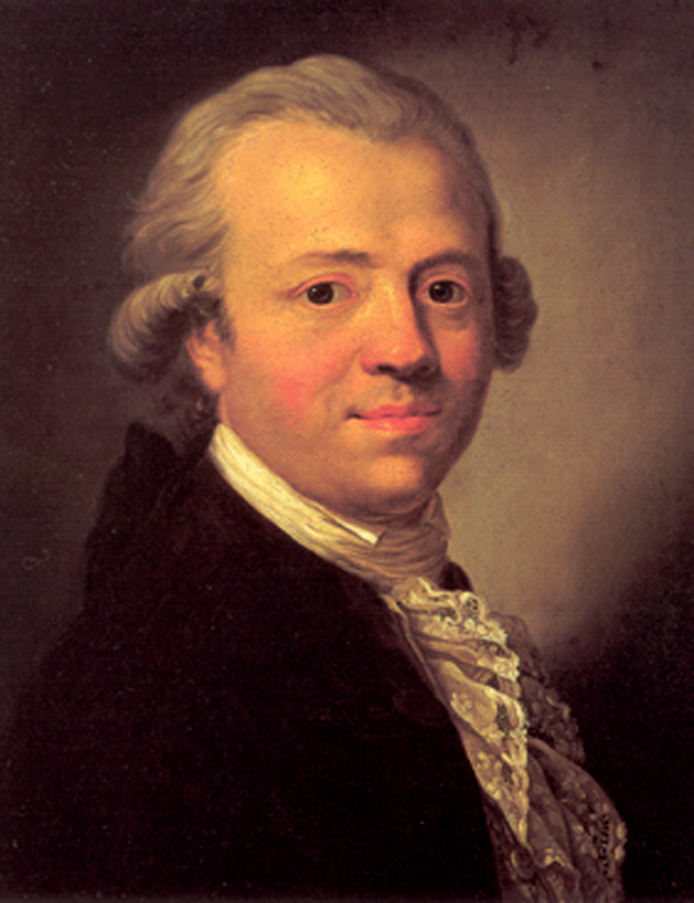FRIEDRICH MAXIMILIAN KLINGER
Friedrich Klinger (1752-1831) was born in Frankfurt am Main, and grew up in modest circumstances. Through the intervention of a scholar he was able to have a suitable education, and from 1772 onwards he moved in the circles of young writers in Frankfurt. He received financial help from Goethe to enable him to follow legal studies in Giessen. He soon proved his talent as a playwright and in 1776 gave up his studies to embark upon a literary career. In 1776 he wrote the play Sturm und Drang, whose title became the name of a well-known movement in German literature marking a reaction to the rationality of the Enlightenment and the transition to Romanticism. Another exponent of this movement was Johann Wolfgang von Goethe (1749-1832), who was his friend in his youth and again after 1811 after a period of estrangement. After literary success faded, he joined the army and ended up in the service of Prince Paul in St Petersburg, with whom he undertook a journey through Europe in 1781-2. Later he fought in the Russian army against the Ottoman Turks. In 1787 he married the daughter of Grigorij Orlov, the court favourite of Empress Catherine II. Partly because of his play Sturm und Drang, Klinger became one of the main exponents of the Sturm und Drang movement. He was influenced by the ideas of Jean Jacques Rousseau and Immanuel Kant, and should be considered a representative of the German Late Enlightenment (Spätaufklärung), together with Christoph Martin Wieland. His works consists of several periods and genres; besides serious drama he wrote trivial novels and plays and (from 1791) philosophical novels. Several of his works were inspired by the Orient in general, or the Thousand and one nights more particularly, including Der Derwisch (comedy; 1780), Geschichte Giafars des Barmeciden (novel; 1791-1793), and Der Faust der Morgenländer, oder Wanderungen Ben Hafis (novel; 1797).
The fragments:
Klinger’s novel Geschichte Giafars des Barmeciden (1791-1793) straddles two literary strands. On the one hand it fits into the tradition of the philosophical novel, referring to both ideal statehood and to the moral nature of man. In this sense it resembles, for instance, Wieland’s Der goldene Spiegel, both in its orientalism and in its discussion of societal organization. On the other hand, it reflects the new tendencies of Romanticism, with its Gothic elements, its sublime landscapes and its concern for human passions and the relationship of human morality with the supernatural forces of religion and magic. In this it resembles Tieck’s novel Abdallah. Both these aspects of the novel are related to a systematically elaborated Oriental setting, which refers to the historical knowledge about the Orient spread by, for instance, d’Herbelot’s Bibliothèque orientale, and to the narrative realm of the Thousand and one nights. The main protagonist of the novel is Giafar, the famous – historical - vizier of the Abbasid Caliph Harun al-Rashid (763-809), whose name is more correctly spelled ‘Ja’far’ or ‘Dja’far’. As a young man, Giafar witnesses the execution of his father by Caliph Hadi. This traumatic experience results in a cynical and bitter view of life and his retiring in an isolated, rather desolate estate. There he encounters Ahmet, a sage who later turns out to be a djinn and who acts as his guide and advisor. They have elaborate discussions about life, nature, fate, the limited comprehension of man and human inclinations and morality. On the advice of Ahmet, Giafar goes on a journey to experience life and he ends up at the court of the king of Indostan. Because of his wisdom he is appointed as vizier, but after palace intrigues he has to flee disguised as a beggar. He returns to Baghdad, but it turns out that his journey has only been a dream. Here Harun al-Rashid has assumed the caliphate who takes him as his vizier. New episodes follow, including the story about Abbasa, the – historical – daughter of Harun, whose intimacy with Giafar, allegedly, led to his execution. Several motifs and narrative turns resemble the narrative material of the Nights, such as the traumatic experience in the beginning, the instructive journey, palace intrigues, the djinn, disguises, the nightly excursions of Harun, etc.

Sources/references:
Nina Berman, German literature on the Middle East; discourses and practices, 1000-1989, University of Michigan Press, Ann Arbor 2013.
Adalbert Elsenbroich, ‘Klinger, Friedrich Maximilian,’ in: Neue Deutsche Biographie, vol. 12, Duncker und Humblot, Berlin 1980, pp. 83-9.
Sven Aage Jorgensen/ Klaus Bohnen/ Per Ohrgaard, Aufklärung, Sturm und Drang, frühe Klassik, 1740-1789, De Boor/ Newald, Geschichte der deutschen Literatur, vol. 6.
Michael Müller, Philosophie und Anthropologie der Spätaufklärung; der Romanzyklus Friedrich Maximilian Klingers, Rothe, Passau 1992.
Erich Schmidt, ‘Klinger, Friedrich Maximilian von,’ in: allgemeine Deutsche Biographie, vol. 16, Duncker und Humblot, Leipzig 1882, pp. 190-2.
Gerhard Schulz, Die deutsche Literatur zwischen französischer Revolution und Restauration, Erster Teil: 1789-1806, De Boor/ Newald, Geschichte der deutschen Literatur, vol. 7/1.
Harro Segeberg, Friedrich Maximilian Klingers Romandichtung. Untersuchungen zum Roman der Spätaufklärung, Winter, Heidelberg 1974.
Weblinks:
http://gutenberg.spiegel.de/buch/geschichte-giafars-des-barmeciden-band-1-2712/1
https://www.deutsche-digitale-bibliothek.de/entity/118563319 (Deutsche Digitale Bibliothek)
http://www.zeno.org/Literatur/M/Klinger,+Friedrich+Maximilian (Zeno.org)
http://gutenberg.spiegel.de/autor/329 (Projekt Gutenberg-DE)
http://www.utlib.ee/ekollekt/eeva/index.php?lang=de&do=autor&aid=56 (Projekt EEVA)